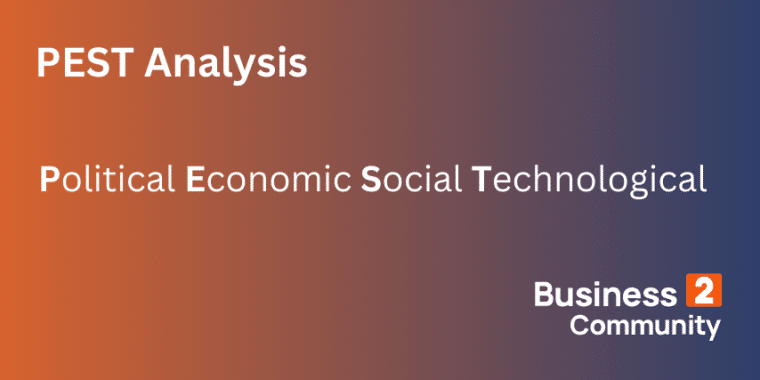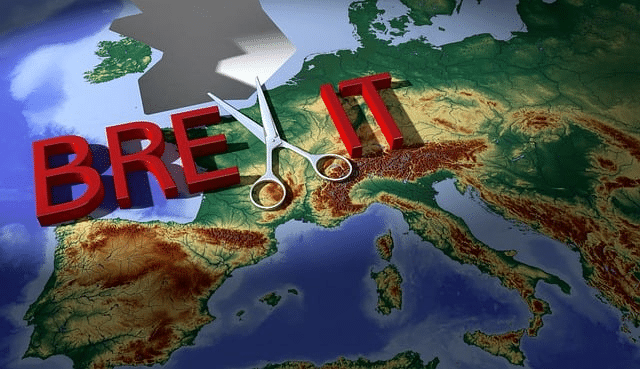PEST analysis – an acronym for political, economic, social, and technological analysis – plays a pivotal role in many business’ strategic planning. This analytical framework allows small and medium-sized business owners, solopreneurs, and even stock traders to identify and evaluate the macro-environmental factors influencing an organization’s operation.
Here at Business2Community, we’ll walk you through the process of conducting a comprehensive PEST analysis, elucidating its immense potential. By sharing relevant, practical examples, we aim to impart an understanding that will empower you to leverage this tool effectively, thereby fostering informed, strategic decision-making in your business ventures.
PEST Analysis – Key Takeaways
- PEST Analysis enables the identification and evaluation of macro-environmental factors (political, economic, social, technological) that influence an organization’s operation.
- Using PEST analysis as a strategic tool can aid with informed decision-making, helping you anticipate potential opportunities and threats in the external environment.
- Regularly conducting a PEST analysis can help businesses remain adaptive and proactive in the face of changing external factors.
What is a PEST Analysis?
A PEST analysis is a strategic business tool that evaluates the four critical external macro-environmental factors (political, economic, social, and technological) impacting an organization. This analysis aids in understanding market growth, decline, business potential, and direction for operations.

Who Needs to Do a PEST Analysis?
PEST Analysis is an important component of strategic planning for a diverse array of stakeholders:
- Small and medium-sized enterprises (SMEs) – The US Chamber of Commerce reported that there were 33.2 million small businesses in the US in 2023, accounting for almost 99.9% of all US businesses. These SMEs can use PEST analysis to spot potential opportunities and threats in the larger environment, helping with strategic planning and decision-making.
- Entrepreneurs and solopreneurs – In FreshBooks Third Annual Self-Employment in America Report, it was estimated that 30 million Americans were self-employed in 2019. These entrepreneurs and solopreneurs can use PEST Analysis to navigate the complexities of the market, understand potential risks and opportunities, and strategically position their business offerings.
- Traders – Traders, especially those dealing with stocks and currencies, can utilize PEST Analysis to grasp a macroscopic view of the market, thus guiding their investment decisions by comprehending potential economic and political shifts.
- Large corporations – PEST analysis provides major corporations with a systematic approach to understanding macro-economic factors, thereby informing corporate strategy, reducing business risks, and identifying economic growth opportunities.
- Non-profit organizations – PEST analysis helps these organizations understand the external environment in which they operate, anticipate potential threats and opportunities, and make strategic business decisions that drive their mission forward.
How to Perform a PEST Analysis in 4 Simple Steps
Developing a PEST analysis involves a straightforward yet comprehensive process centered on understanding the macro-economic PEST factors that can impact your business. Here’s a step-by-step guide to creating your PEST analysis:
Step 1: Identify Potential Factors
This initial step is essential to outline the broad economic and cultural factors that influence your business environment directly or indirectly. The PEST analysis helps in this process:
Political Factors
Assess the impact of government policies, regulations, and overall political environment on your business. Key questions to consider might include:
- What is the political climate of the country/region where your business operates?
- How do government regulations affect the business environment?
- What are the implications of tax policies and trade regulations on your business?
Economic Factors
Reflect on the economy’s current condition and how it could influence your business. Relevant questions to consider include:
- What is the current economic growth rate?
- How do the inflation and interest rates impact business costs and consumer spending?
- What is the level of employment/unemployment and other job market trends?
Social Factors
Consider the social and cultural influences that could affect your business. Some potential socio-cultural factors to explore are:
- What are the prevalent societal attitudes and behaviors?
- How do demographic trends such as the population growth rate affect the business?
- What influence do lifestyle trends have on your market?
Technological Factors
Examine the role of technology in your business sphere. Questions to guide your analysis might include:
- What are the key technological advancements in your industry?
- How can these technological developments benefit your business?
- What is the level of technology adoption among your target consumers?
Step 2: Find Opportunities
After considering the four PEST pillars, contemplate potential opportunities for your business. For instance, during the COVID-19 pandemic, Zoom harnessed the socio-cultural and technological shifts that came with global lockdowns, resulting in significant business growth.

Zoom’s revenue skyrocketed, increasing by over 300% in the fiscal year ending January 31, 2021, and continued to grow by 55% in the following fiscal year, reaching $4.10 billion. Zoom was able to capitalize on the changing dynamics of work and communication, establishing itself as a major player in the evolving landscape of remote and hybrid work.
Step 3: Consider Threats
Use the data gathered in the first step to consider potential threats to your business. While identifying these threats, consider developing contingency plans to mitigate potential risks.
For example, Brexit’s resulting shift from free trade with EU nations to new trade restrictions including tariff and non-tariff measures, significantly disrupted supply chains.

The UK’s Office for National Statistics reported a 41% decline in British exports to the EU in January 2021 following the end of the Brexit transition, underlining the expansive effects of regulatory changes.
Step 4: Implement Action
After collecting and processing this information, it’s time to execute strategic planning and establish business goals. Understanding these potential threats, factors, and opportunities will aid your team in the decision-making process and shape your future strategy.
Highlight key areas of your business plan and elucidate how specific external factors influence these decisions. For example, if your business is located in a college town, you might strategize to hire more entry-level employees to cater to the local employment patterns and control labor costs.
PEST Analysis Examples
To help you better understand PEST factors, let’s consider two simple yet realistic scenarios: a fitness trainer intending to start classes in a local park, and an online retailer planning on selling handmade candles.
PEST Example 1: Fitness Classes in a Local Park
- Political factors: The trainer needs to understand the park and local government policy and regulations concerning public gatherings, and any permits or licenses required.
- Economic factors: The trainer should take into account the local economic environment such as local disposable income, unemployment rates, and the willingness of people in the area to pay for fitness classes.
- Social factors: The trainer should consider demographics, health awareness levels, and the prevailing attitudes towards outdoor fitness classes in the local community through market research.
- Technological factors: The trainer might want to explore the usage of fitness apps, online booking systems, and popular social media platforms for advertising and client engagement.
PEST Example 2: Selling Handmade Candles Online
- Political factors: It’s crucial to understand the regulations around online sales, tax implications, trade restrictions, and shipping restrictions or requirements.
- Economic factors: The retailer should consider current market trends, consumer spending habits, and the impact of economic forecasts on consumer purchasing power.
- Social factors: The retailer should account for factors such as popular designs or scents, the importance of eco-friendly products, and the prevalence of gift-buying in the target market.
- Technological factors: The retailer needs to evaluate the effectiveness of different online selling platforms, digital marketing strategies, and the role of new technology in the production process.

When to Use PEST Analysis
A PEST analysis, while valuable, is not always necessary for every situation. In this section, we will explore when it is most effective and beneficial to use a PEST for your analysis in your strategic planning process.
Adding a New Product Line
Conducting a PEST process when adding a new product line can assist in understanding the market conditions, potential demand, and possible social trends related to the product. It can help in forecasting the product’s success and aligning the marketing strategy accordingly.
Hiring a New Team Member
When hiring a new team member, running through PEST factors can be valuable to understand the wider socio-economic conditions, such as the availability of skilled labor, wage levels, and employment regulations, which can influence the recruitment process and choice of candidates.
Expanding Internationally
When considering international trade, a PEST-level analysis becomes crucial for examining the political stability, economic conditions, government policy, socio-cultural compatibility, and technological advancements in the targeted country. It helps identify potential risks, regulatory hurdles, market dynamics, cultural nuances, and technological infrastructure, enabling informed decision-making and strategic planning.
How to Adjust a PEST Analysis
The outcomes of your PEST data analysis are not set in stone and are subject to change as political, economic, social, and technological environments evolve. Business owners and traders can make adjustments in their strategies based on the conclusions derived from a PEST analysis. Here are some real-world examples:
- Digital transformation: If the technological factor in your PEST analysis reveals that companies are gaining a competitive edge through new technology, consider accelerating your business’s digital transformation. This might include adopting new software, improving your online presence, or investing in automation.
- Pricing strategy: Economic factors such as inflation, interest rates, and changing consumer spending habits may lead to modifications in your pricing strategy. If consumers are more price-sensitive, consider implementing discounts or loyalty programs.
- Changing business location or market: Political instability or unfavorable government policies could warrant a change in your operating region. Registering your business in a different country or exploring new markets could be potential strategies.
- Overhead costs: External forces in the economy, such as a rise in minimum wage or raw material costs, could pose significant risks and necessitate a review of your overhead costs. Consider cost-cutting measures or ways to increase operational efficiency.
- Product or service modification: Social trends can greatly impact product or service reception. If customers are becoming more eco-conscious in the wider business environment, for example, you might consider introducing sustainable practices in your production process.
Limitations of PEST Analysis
While PEST analysis provides a useful framework for understanding the macro environment in which your business operates, it’s important to be aware of its limitations. One of the key limitations is the difficulty of predicting unforeseen future changes in the political, economic, social, and technological landscape.
Another limitation is the lack of internal analysis which leaves out factors such as resources, capabilities, and internal business operations. Also, this framework may not cover industry-specific factors which are critical for certain businesses, thus requiring additional industry analysis tools. You can consider supplementing a PEST analysis with other tools like SWOT Analysis or Porter’s Five Forces for a more comprehensive business analysis.
The Value of PEST Analysis
Conducting a PEST analysis offers businesses an insightful and holistic view of the macroeconomic factors impacting their operations. It equips you with a comprehensive understanding of the political, economic, social, and technological landscapes, thereby providing a robust foundation for strategic decision-making in your target markets.
Whether it’s planning for a new product launch, hiring a new team member, or adjusting business strategies, PEST analysis is a valuable tool to anticipate potential opportunities and threats. It can also guide your business in making necessary adjustments in response to external changes, thereby enhancing your competitiveness, resilience, and strategic thinking.
Importantly, while PEST analysis has its limitations, these can be mitigated through the use of complementary tools such as SWOT analysis, Porter’s Five Forces analysis, and detailed market and financial Analysis. Therefore, the consistent application of PEST analysis in your business operations can significantly contribute to its success.